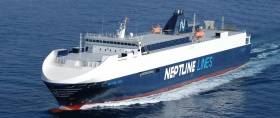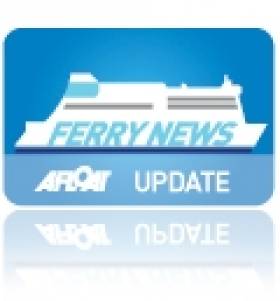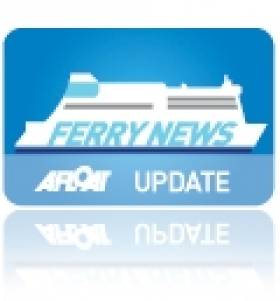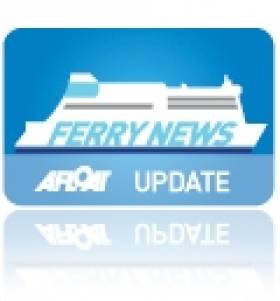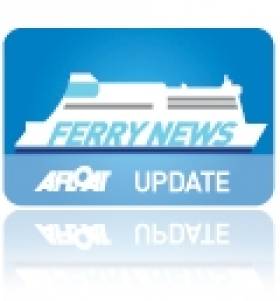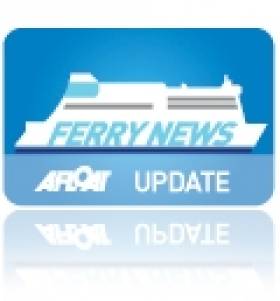Displaying items by tag: P&O Ferries
Greek Charter Draws to A Close on P&O Dublin-Liverpool Service
#GreekCharter - The charter of a Greek vessel to P&O Ferries to cover dry-docking of the one of three ropax ships on the Dublin-Liverpool is drawing to a close, writes Jehan Ashmore.
Piraeus based Neptune Lines, a vehicle logistics operator have their Neptune Aegli operating in place of P&O’s European Endeavour which is at Cammell Laird, Birkenhead for annual overhaul.
The Spanish built European Endeavour is scheduled to re-enter service tomorrow with an arrival to Dublin in the morning. It is expected the 366 passenger / 112 lorry ropax will appear with a modified version of the traditional P&O livery scheme already introduced on the route's Dutch built sisters, Norbank and Norbay. The pair are also ropax's having been built originally for North Sea service.
While the ‘European’ is away, the 1,550 freight vehicle lane metre capacity Neptune Aegli presented a sleek looking profile. The ship built in 2002 is not a ropax but is designated a Pure Car & Truck Carries (PCTC) which can transport 1,800 car units. Neptune Lines has operations in 20 countries and more than 30 key ports, focusing on the Mediterranean and Black Sea.
P&O Ferries Enjoys Increase In HGV Crossings
#NorthSea - P&O Ferries in early January announced that it has seen an 11% year-on-year increase in HGVs crossing between the UK and the continent on its Hull-Rotterdam route, reports Ships Monthly.
The level of trade on this P&O Dutch route amounts to more than 5,000 extra vehicles being carried on the North Sea route during 2015, contributing to a total of 52,000 HGVs.
The route is operated by the giant 59,925 tonnes sisters Pride of Hull and Pride of Rotterdam, among the largest passenger ferries in Europe providing first class facilities for truck drivers too. They each carry 1,360 passengers, 205 cars and 263 trailers. For more on the P&O story, click here and freight boost on their premier Dover-Calais service.
Afloat adds, that leadship Pride of Hull features an 'Irish Bar' and was built in the same year of Irish Ferries, flagship, Ulysses of 50, 938 tonnes. She is the fifth largest ferry in tonnage terms to operate in UK waters.
As previously reported, Ulysses had gone to A&P Falmouth for annual refit and which has since been completed. The cruiseferry departed the Cornish facility last night and at time of writing is bound for Dublin Port having transitted St. Georges Channel.
P&O Ferries Closes Larne-Troon Seasonal Fast-Ferry Service
#RouteClosure - P&O Ferries has announced the closure of the Larne-Troon route following a comprehensive reviews of its options.
The decision to close its loss-making Northern Ireland-Scotland route is with immediate effect, however the company through this media statement has confirmed it will continue to operate its full Larne-Cairnryan route services throughout 2016 and into the future.
P&O Ferries has proudly operated this additional seasonal route since 2003, but the stark reality is that the company is continuing to make losses. Sadly the income from ticket sales is not sufficient to cover the annual vessel (fast-craft Express not to be chartered in 2016, as previously reported on Afloat) and port operating costs.
In a final attempt to make the route economic the company reduced the service in the off-peak months last year, whilst maintaining the full service in the peak months of July and August. Whilst this measure did significantly reduce the operating costs, the route remained loss-making.
Since the last sailing at the end of September, P&O Ferries has continued to negotiate with a number of suppliers and other organisations, including the search for a lower cost chartered fast-craft to be able to continue, but we have been unable to develop a solution for the company.
There will be no redundancies, with all permanent staff being found alternative roles within the company.
For customers, the company has confirmed that in 2016 the P&O Larne-Cairnryan service will continue to operate up to seven sailings each way every day of the year. These operations are to maintain its reliable service for freight, tourist and domestic customers, on what is still the shortest and most frequent crossing on the North Channel between Northern Ireland and Scotland.
The purpose-built European Highlander and European Causeway vessels will also be undergoing £500,000 of on-board improvements over the next 18 months, and before Easter this year will be adding over 50 seats to each ship. In addition to upgrading or updating a number of the passenger areas and facilities, including the provision of ‘Free Wi-Fi that Works’, and using more locally sourced produce and recipes for the food courts.
The company believes that this decision will enable a more secure future for its employees and for its customers on the Northern Corridor.
Freight Record on Dover-Calais Broken By P&O Ferries
#DoverFreightRecord - A record volume of freight has been carried between Dover and Calais by operator P&O Ferries in the third quarter of the year.
According to Lloyds Loading List, the ferry company transported 367,000 units of freight across the Channel between July and September - up 30% on the same period last year and the best single quarter since 2003.
P&O Ferries’ CEO Helen Deeble said: “This quarter has been unprecedented, with the strike by French seamen and the temporary closure of the port of Calais bringing major logistical challenges.”
But she said demand for cross-Channel transport was only going to increase, driven by a rising population and a recovering economy.
“We have increased the number of sailings we make between Dover and Calais to 58 a day and brought a sixth ship back into service on the route in order to make sure that we are best placed to meet that demand."
Freight comprises around two-thirds of P&O Ferries’ business, with tourist traffic accounting for one-third.
#P&Oferries – Lysblink Seaways under repair in Greenock, Scotland as previously reported on Afloat, is where by coincidence DFDS Seaways operate a container service to Liverpool and from where they have chartered a freight-ferry to P&O Ferries, writes Jehan Ashmore.
Firstly is the charter by DFDS Logistics Rederi AS of Lysblink Seaways to Sea-Cargo based in Bergen.
The starboard side-loading paper products carrier was due to have called to Skogn, in Norway last month from Belfast but instead the 129m long vessel went aground on the west Scottish coast.
She was re-floated and towed to the Clyde where she entered Garvel Clyde's James Watt Dock at Inchgreen.
While on the Irish Sea, the freight-only Anglia Seaways charter from DFDS to serve P&O Ferries Dublin-Liverpool route had only begun earlier this week having called to Merseyside last weekend from The Netherlands.
Anglia Seaways is covering the roster of P&O's ro-pax Norbank which is in dry dock at Cammell Laird, Birkenhead. Also maintaining the Ireland-England central Irish Sea route is sister Norbay and larger ro-pax European Endeavour which also carries motorist cars and freight vehicles.
The Danish flagged 120-trailer Anglia Seaways is otherwise understood to normally operate on the North Sea, running Rotterdam-Immingham on the UK's east coast. It is from Anglia where she originally began a career with Norfolkline (a Maersk subsidiary) but running from Felixstowe firstly as the Maersk Anglia.
It's almost full circle with Anglia Seaways presence on the Irish Sea, as she has served on several routes, the most recent a charter to Seatruck Ferries on the Warrenpoint-Heysham route until last year.
More apt was the role she played for DFDS Seaways when the Danish shipping giant's acquisition of Norfolkline Irish Sea operations in 2010.
The involved a network of routes that would be later sold to Stena Line, except for the Dublin-Birkenhead service in which Anglia Seaways served until January 2011.
This marked the final trace of the short-lived DFDS freight and 'passenger' operations that Stena would eventually swallow up to further consolidate as the dominant player on the Irish Sea.
For a more in-depth coverage of this period in the Irish Sea ferry industry (including a photo of Anglia Seaways) while still sporting the distinctive pale blue corporate Maersk hull colour.
Also seen at Dublin Port was the ro-pax Liverpool Seaways, which would head off for a career with DFDS on the Baltic Sea.
P&O Express Lays Up Leaving Ro-Pax Sisters on Scottish Service
#P&ONorthChannel - As the Express sailed into Belfast Lough this morning, the P&O Ferries fast-craft's presence marked the end of her summer-only season service on the Larne-Troon route, writes Jehan Ashmore.
Express (1998/5,902grt) is standing down for the Winter months at a berth on the Lagan in Belfast Harbour, having served the season of the 1 hour route linking Antrim and Ayrshire.
The InCat 91m fast-craft with a capacity for 868 passengers and 195 cars, has been in service on this link for nine years.
In the previous winter lay-up again in Belfast, she was refitted at cost of £500,000 to upgrade standards in service. No doubt the refit was in response to Stena Line's 'Superfast' conventional tonnage introduced in late 2011 on the Belfast-Cairnryan route.
In addition upgrades were also applied to P&O Ferries conventional ro-pax sisters serving Larne to Cairnryan crossings taking 1 hour 45 minutes in competition to Stena's longer passage time of an added 30 minutes.
P&O Ferries Gears Up Ahead of Giro d’Italia
#FerryGearsUp -With the Giro d'Italia, one of the world's most prestigious cycling events heading to Northern Ireland in May, P&O Ferries has put together special offers for travellers arriving from the UK for the major cycling event.
As previously reported on Afloat.ie, earlier this month the InCAT built 91m P&O Express reopened the 2014 season of the Troon to Larne service, and where foot passengers can travel for £30 return, while motorists can take up to a 5 day return for £119.
Alternatively, passengers can take the ferry from Cairnryan to Larne for £99 for a car plus driver or £25 for foot passengers.
Neal Mernock, Sector Director, P&O Ferries Irish Sea said: "There is huge excitement building as the Big Start approaches and we're delighted to be playing our part with these fantastic offers that will enable fans to travel to Northern Ireland to enjoy this world class event."
This is a time limited offer and bookings must be made by Sunday 11 May. Passengers can travel on this offer from Thursday 8 May to Monday 12 May 2014.
Passengers on these routes can also upgrade to the Club Lounge. Tickets booked in advance cost £12 per person while tickets purchased on board cost £14 per person.
For further information visit: www.POferries.com
P&O Ferries ‘Express’ Returns to Troon Service!
#P&Oexpress - P&O Ferries fast-craft Express that sails between Larne-Troon returns to service this week and just in time for the forthcoming holiday season.
The 91m InCAT built Express is the fastest ferry on the most direct route for passengers travelling from Northern Ireland to central Scotland.
Glasgow is just 45 minutes from the Port of Troon and Edinburgh is not much further, making day trips – whether for business or pleasure, easy and accessible.
Neal Mernock, Sector Director – Irish Sea, P&O Ferries, said: "I'm delighted to announce the return of the Fastcraft service between Larne and Troon. From today, the fast-craft provides passengers sailing from Northern Ireland an even greater choice on their Irish Sea crossings. It's a popular service for both leisure and business customers and we're looking forward to welcoming everyone on board today and throughout the season".
With up to 4 sailings a day, prices start from £99 one way to Troon for a car and one person, passengers also have the option to upgrade to Club Lounge. Tickets booked in advance cost £12 per person while tickets purchased on board cost £14 per person.
For further information visit: www.poferries.com
Sailing Champion Tiffany Brien Launches P&O Ferries Wi-Fi Connection
#FerryWiFi - Former Miss Northern Ireland and sailing champion Tiffany Brien helped P&O Ferries launch 'Wi-Fi that Works' - a new service giving ferry passengers access to a high quality, dependable Wi-Fi connection sailing between Larne and Cairnryan.
Otherwise known as 'Peanut Butter Girl', the well-connected fitness fanatic with 33,000 Facebook fans enjoyed the speedy new service on-board P&O Ferries European Highlander.
For £3, passengers can spend up to 90 minutes surfing the web during the crossing with the option to stop and restart the service, conveniently saving minutes for another time. Payment can be made online using a credit or debit card or with cash at the on-board information desk.
Announcing the launch of 'Wi-Fi that Works', Neal Mernock, Sector Director, Irish Sea at P&O Ferries said: "We know it's important for all our passengers, whether travelling for business or leisure that they're able to go online and stay connected throughout their journey.
"We have worked hard to guarantee that the Wi-Fi service we have installed is of the highest quality, ensuring a reliable and unbroken service for passengers sailing between Larne and Cairnryan".
The Wi-Fi service is free of charge for Club Lounge passengers. Club Lounge tickets booked in advance cost £12 per person while tickets purchased on board cost £14 per person.
Christmas Mystery Discount Giveaway from P&O Ferries
#MysteryDiscount – With the holiday season underway, P&O Ferries, has launched a surprise discount giveaway for all passengers travelling between Scotland and Northern Ireland.
Passengers can book their travel for 2014 on the Larne-Cairnryan/Troon routes and will receive a discount of up to 25%. To avail of offer, bookings must be made by 7 January 2014.
Neal Mernock, Sector Director - Irish Sea, P&O Ferries said: "As operators of the shortest, fastest crossings between Northern Ireland and Scotland we are delighted to be offering these fantastic discounts which will allow even more people to get away throughout 2014. Join us on board throughout the year for a comfortable and relaxing journey and hassle free travel."
All ferries boast Club Lounge offering complimentary newspapers, magazines and refreshments. In addition sockets for passengers to use their laptops, tablets and mobile phones. Club Lounge tickets booked in advance cost £12 per person while tickets purchased on board cost £14 per person.
P&O Ferries will be highlighting the Christmas mystery giveaway through direct mail, website and through social media. Travel must take place between 1January and 31 December 2014 with the offer open to everyone with the exception of foot passengers, bicycles, motorhomes and caravans.
For full detail and conditions see details from www.poferries.com



























